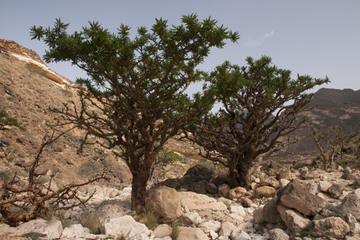Land of Frankincense
TIME : 2016/2/22 13:43:57

Land of Frankincense
From the height of ancient Greece and Egypt, into the Iron and Islamic Ages and through much of the 17th century, the frankincense trade thrived throughout the Arab Peninsula, North Africa, the Mediterranean, India and China. Caravans, or traveling groups of traders, would walk the Silk Road throughout these areas and form makeshift settlements close to their most valuable products; few were more lucrative to trade than frankincense.
An aromatic resin used as incense in religious ceremonies and private homes, frankincense is harvested by peeling the bark from its hardy namesake tree (also known as Boswellia sacra), which can grow just about anywhere – even out of solid rock. Technically called olibanum, and especially sacred to Jews for its appearance in the Torah, the resin was given its more common name when Frankish Crusaders brought it back with them to Europe.
In the Dhofar province of southern Oman, the World Heritage Site is composed of the ancient frankincense trees at Wadi Dawkah, the remains of the caravan settlement of Shisr and Wubar, and the trade ports of Khor Rori and Al-Baleed, bordering the Arabian Sea. This area is one of the world’s greatest sources of evidence of the culturally influential frankincense trade, and offers well-preserved examples of medieval-era Arabian architecture.
These days, frankincense remains big business in Oman, and can be purchased from dedicated tradesmen in markets all over the country.
